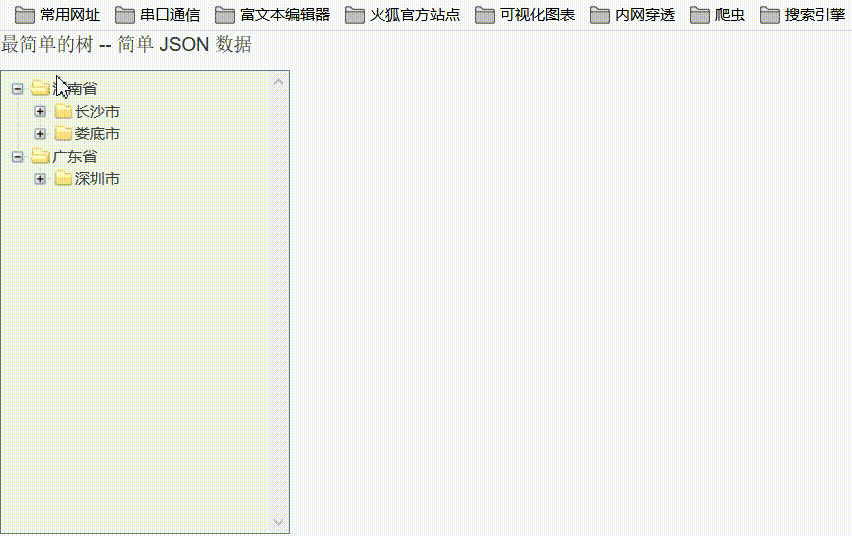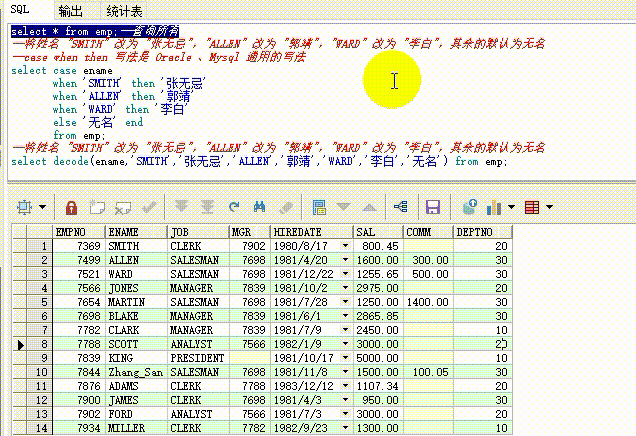目录
递归查询·需求分析
递归查询·准备数据
递归查询实现·start with...connect by prior
case when 条件表达式
rowid 伪列删除表中重复数据
递归查询·需求分析
1、开发中经常会有这种需求实现,如下所示是 JQuery-Ztree 树插件的效果:

2、如上所示的 前端 tree 需要的数据格式如下(关系也很简单,就是自己的 id 以及显示的 name,与自己父节点 id):
var zNodes =[
{ id:1, pId:0, name:"湖南省", open:true},
{ id:11, pId:1, name:"长沙市"},
{ id:111, pId:11, name:"芙蓉区"},
{ id:112, pId:11, name:"天心区"},
{ id:113, pId:11, name:"岳麓区"},
{ id:114, pId:11, name:"开福区"},
{ id:115, pId:11, name:"雨花区"},
{ id:116, pId:11, name:"望城区"},
{ id:12, pId:1, name:"娄底市"},
{ id:121, pId:12, name:"娄星区"},
{ id:122, pId:12, name:"冷水江市"},
{ id:123, pId:12, name:"涟源市"},
{ id:124, pId:12, name:"双峰县"},
{ id:125, pId:12, name:"新化县"},
{ id:1251, pId:125, name:"白溪镇"},
{ id:1252, pId:125, name:"洋溪镇"},
{ id:1253, pId:125, name:"吉庆镇"},
{ id:1254, pId:125, name:"曹家镇"},
{ id:2, pId:0, name:"广东省", open:true},
{ id:21, pId:2, name:"深圳市"},
{ id:211, pId:21, name:"罗湖区"},
{ id:212, pId:21, name:"福田区"},
{ id:213, pId:21, name:"南山区"},
{ id:214, pId:21, name:"宝安区"},
{ id:215, pId:21, name:"坪山区"},
{ id:216, pId:21, name:"龙岗区"}
];3、本文介绍的重点不是前端如何实现树形菜单的显示,而是后台如何查询数据库这种数据。
递归查询·准备数据
1、注意根据上面前端树结构的需要,后台返回的数据必须有 id,pId,以及 name,至于 menu_level(层级) 字段可有可无,可以根据实际业务决定。
2、前端使用的树不同,数据格式可能也会大同小异,如下所示字段名称并没有和上面 tree 插件要求的属性名称完全一样,这只需要查询的 as 一下别名即可。
准备数据脚本:Oracle 新建地区级联数据.sql
SQL 运行完成后,Oracle 数据库数据如下:

递归查询实现·start with...connect by prior
1、connect by 是结构化查询中用到的,其基本语法是:
select … from tablename where 条件1 start with 条件2 connect by 条件3 order by 列 ; 条件1 是过滤条件,用于对返回的所有记录进行过滤筛选 |
2、下面循序渐进式的进行编写 SQL:
--查找树中的所有顶级父节点(1级菜单)
select * from scott_menu sm where sm.parentId = 0;
select * from scott_menu sm where sm.menu_level= 1;
--查找某个节点(如id为1)的直属子节点(所有儿子,不包括孙子)
select * from scott_menu sm where sm.parentId=1;
--查找某个节点下的所有子节点(包括所有子孙后代)。如下所示查询 id=1 的菜单下的所有子孙节点
select * from scott_menu sm start with sm.id=1 connect by prior sm.id = sm.parentId;--前一条记录的 id 是后一条记录的 parentId
--查找所有1级菜单下的全部子孙节点,即查询整颗树,这也是实际中最常见的操作,有了上面的基础,现在则轻而易举了。
--将起始节点设置为所有的一级菜单即可。这查询出来的数据完全符合前端页面的格式,只需要后台再封装成 json 返回给页面即可
select * from scott_menu sm start with sm.parentId=0 connect by prior sm.id = sm.parentId;
select * from scott_menu sm start with sm.menu_level=1 connect by prior sm.id = sm.parentId;
--如果需要对查询的结果进行过滤,则使用 where 条件进行筛选,并以 id 倒叙
select * from scott_menu sm where sm.title like '%区%' start with sm.parentId = 0 connect by prior sm.id = sm.parentId order by id desc;
--需求:查询 "白溪镇" 以及所在的上级 市、省份
select * from scott_menu sm start with sm.title = '白溪镇' connect by sm.id = prior sm.parentId;
--起始第一条数据为 '白溪镇',如何会递归查询下一条的 parentId 等于自己 id 的记录,以此类推
--查询某个节点(如 id= 16)的兄弟节点(亲兄弟,有同一个父节点)
select * from scott_menu sm where exists (select * from scott_menu sm2 where sm.parentId=sm2.parentId and sm2.id=16);
从上面查询整颗树的结果可知,只需要在后台封装好前端所需要的 json 格式的数据返回,前端即可显示。
case when 条件表达式
1、条件表达式格式(Oracle 与 Mysql 通用的写法)(注意:返回值的数据类型必须一致,即不能返回值1是 number,而返回值2确实 char):
语法 1: CASE 字段 语法 2: CASE |
--方式一。最简单的用法
select t.stuid,t.stuname,case t.gender when '男' then 1 when '女' then 0 else -1 end from student t;
--两者结果完全一样
--方式二,使用条件查询,此时 case 后面不要再加 字段
select t.stuid,t.stuname,case when t.gender = '男' then 1 when t.gender = '女' then 0 else -1 end from student t;
--如果性别为 "男" 则返回 1,否则返回本来的值。注意返回的数据类型必须一致
select t.stuid,t.stuname,case when t.gender = '男' then '1' else t.gender end from student t;
-- 薪资(sal) >= 5000 的加薪 10%,小于 5000的加薪 20%
update emp t set t.sal = case when t.sal >= 5000 then t.sal * 1.1 else t.sal * 1.2 end;2、Oracle 独有的函数写法:decode(字段,if1,then1,if2,then2,....)
select * from emp;--查询所有
--将姓名 "SMITH" 改为 "张无忌","ALLEN" 改为 "郭靖","WARD" 改为 "李白",其余的默认为无名
--case when then 写法是 Oracle 、Mysql 通用的写法
select case ename
when 'SMITH' then '张无忌'
when 'ALLEN' then '郭靖'
when 'WARD' then '李白'
else '无名' end
from emp;
--将姓名 "SMITH" 改为 "张无忌","ALLEN" 改为 "郭靖","WARD" 改为 "李白",其余的默认为无名
select decode(ename,'SMITH','张无忌','ALLEN','郭靖','WARD','李白','无名') from emp;
rowid 伪列删除表中重复数据
1、oracle 数据库的伪列 rowid 表示该条数据在 oracle 数据库中的物理存储位置,值为长度18的字符串(如 AAATRXAAGAAAK1XAAA)。oracle 内部通常就是使用它来访问数据的,它可以唯一标识一行数据。伪列只能查询,不能增删改
2、rowid 伪列默认不显示,像 rownum 一样需要显示指定,如 select t.*,rowid from student t ;
3、和 rownum 行号不同的是,rowid 不但可以作为 select 的 where 条件,还可以作为 update、delete 等操作的 where 条件,如:delete from student t where t.rowid = 'AAATRXAAGAAAK1XAAA';
4、所以生产中有一个常见的操作就是用 rowid 来删除表中完全重复的数据,下面先准备测试数据:
--创建学生表
create table STUDENT (
stuid VARCHAR2(16) not null,
stuname VARCHAR2(16) not null,
gender VARCHAR2(2) not null,
age NUMBER(8) not null,
stuaddress VARCHAR2(50),
enrolldate DATE
);
--插入数据
insert into student values('1','张三丰','男',108,'武当派开山祖师',to_date('2019-08-25 09:25:33','yyyy-mm-dd hh24:mi:ss'));
insert into student values('1','张三丰','男',108,'武当派开山祖师',to_date('2019-08-25 09:25:33','yyyy-mm-dd hh24:mi:ss'));
insert into student values('2','郭襄','女',56,'峨嵋派开山祖师',to_date('2015-06-25 15:00:33','yyyy-mm-dd hh24:mi:ss'));
insert into student values('2','郭襄','女',56,'峨嵋派开山祖师',to_date('2015-06-25 15:00:33','yyyy-mm-dd hh24:mi:ss'));
insert into student values('3','杨不悔','女',27,'明教右使千金',to_date('2020-09-21 11:45:20','yyyy-mm-dd hh24:mi:ss'));删除表中重复数据行方式一:rowid
--根据单个字段(stuid)进行分组,然后删除重复数据,min(rowid) 取其中 rowid 最新的上,同理可以 max(rowid)
delete from student where
stuid in ( select stuid from student group by stuid having count(*) > 1)
and
rowid not in (select min(rowid) from student group by stuid having count(*) > 1);
--根据多个字段进行分组,然后删除重复数据,min(rowid) 取其中 rowid 最新的上,同理可以 max(rowid)
delete from student where
(stuid,stuname) in ( select stuid,stuname from student group by stuid,stuname having count(*) > 1)
and
rowid not in (select min(rowid) from student group by stuid,stuname having count(*) > 1);删除表中重复数据行方式二:先取后删再插
--先使用 distnct 关键字进行去重查询,去除结果集中重复的数据行。如果需要对整个表进行去重,则省略 where 条件即可!
select distinct * from student t where t.stuid < 3 order by stuid;
--新建临时表(student_temp),并将去重结果存入进去
--使用 order by 关键字的目的是让后面从临时表再重新插回目标表的时候,数据仍然保持和原来一样的顺序.
create table student_temp as select distinct * from student t where t.stuid < 3 order by stuid;
delete from student t where t.stuid < 3;--然后删除目标表(student)中的所有重复数据
insert into student select * from student_temp;--最后将临时表(student_temp)的数据再插入到目标表(student)中.
drop table student_temp;--删除临时表 student_temp


















